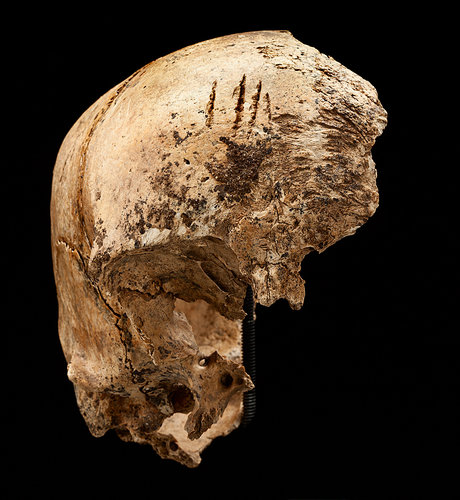 |
| The skull shows marks from four shallow chops. These remains are evidence of cannibalism for survival in the winter of 1609 in historic Jamestown. |
Evidence of Cannibalism Found at Jamestown Site
 |
| The skull shows marks from four shallow chops. These remains are evidence of cannibalism for survival in the winter of 1609 in historic Jamestown. |
By NICHOLAS WADE
Archaeologists excavating a trash pit at the Jamestown colony site in Virginia have found direct evidence of the cannibalism that had long been known to have occurred among the desperate population. Cut marks on the skull and skeleton of a 14-year-old girl show her flesh and brain were removed, presumably to be eaten by the starving colonists during the harsh winter of 1609.
The remains were excavated by archaeologists led by William Kelso of Preservation Virginia, a private nonprofit group, and analyzed by Douglas Owsley, a physical anthropologist at the National Museum of Natural History in Washington. The skull bears tentative cuts to the forehead, followed by four strikes to the back of the head, one of which split the skull open, according to an article in the Smithsonian magazine, where the find was reported.
It is unclear how the young girl died but she was probably dead already and even buried before being butchered. According to a letter written in 1625 by George Percy, president of Jamestown during the starvation period, the famine was so intense “thatt notheinge was Spared to mainteyne Lyfe and to doe those things which seame incredible, as to digge upp deade corpes outt of graves and to eate them.”
The girl’s remains were discovered last summer in a refuse dump containing horse and dog bones. From the state of her molars, she is judged to have been 14 years old. Isotopes in her bones indicate she had eaten a high-protein diet, so was probably the daughter of a gentleman, not a maidservant.
The Jamestown site was long thought to have eroded into the James River but was rediscovered by Dr. Kelso and other archaeologists who began excavations in 1994. The site was founded in 1607 by the Virginia Company of London on swampy ground unsuitable for agriculture. The local Powhatan Indians at first welcomed and fed the settlers. But by 1609, when relations with the Indians deteriorated and a supply ship failed to arrive, the colony was in desperate straits. Only 61 of the 500 colonists survived the famine.
Bernard Bailyn, a Harvard historian and expert on colonial history, said the new report of cannibalism was very interesting. “It’s part of the disaster the company faced and the terrible problems they had at the beginning,” he said. As to the reasons the Virginia company failed to provide adequate support to its colony, “Whose fault it was is very difficult to say,” Dr. Bailyn said.